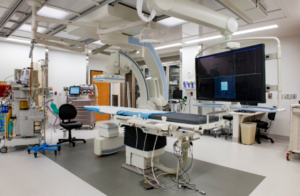Approximately 20-40% of women 35 years and older have uterine fibroid tumors. While some women don’t experience any symptoms, many experience pain and discomfort that changes the way they act and live.
Common symptoms include:
- Heavy menstrual bleeding
- Menstrual periods lasting more than a week
- Pelvic pressure or pain
- Frequent urination
- Difficulty emptying the bladder
- Constipation
- Backache or leg pains
What are Uterine Fibroids?
Fibroids are muscular tumors that grow in the wall of the uterus. The symptoms can affect your daily life and, in some cases, fertility complications. There are many types of uterine fibroids. They are classified according to their location.
- Subserosal Fibroids: Develop on the outer uterine wall and put pressure on the surrounding organs. Symptoms include pelvic pain and pressure, not bleeding.
- Intramural Fibroids: The most common; can be mistaken for pregnancy or weight gain. Symptoms include excessive menstrual bleeding, pelvic pain, frequent urination and pressure.
- Submucosal Fibroids: The least common; develop under the lining of the uterine cavity and can block the fallopian tubes leading to fertility complications. Symptoms include very heavy, excessive menstrual bleeding and prolonged menstruation.
- Pedunculated Fibroids: Grow on a stalk either into the cavity of the uterus or from the outside of the uterus into the pelvis. Symptoms include pain and pressure.
Uterine Fibroid Embolization
While there are a few different treatment options, uterine fibroid embolization (UFE) is a minimally invasive that offers maximum relief. During the 60-90 minute procedure, an Interventional Radiologist will make a small incision into the femoral artery and block the blood supply to the uterine fibroids, causing them to shrink. Most patients will go home the same day as or stay one night in the hospital. Other benefits of UFE include:

- Preservation of the uterus
- Decrease in heavy menstrual bleeding, pelvic pain and/or pressure
- Decrease in urinary dysfunction
- Virtually no blood loss
- Covered by most insurance companies
- Shorter hospital stay and fewer complications when compared to a hysterectomy
If you experience heavy, excessive menstrual bleeding, pelvic pain and pressure or urinary incontinence and think you may have uterine fibroids – don’t keep relief waiting.
Visit our website and talk to your OB-GYN to learn more about the uterine fibroid embolization procedure.

